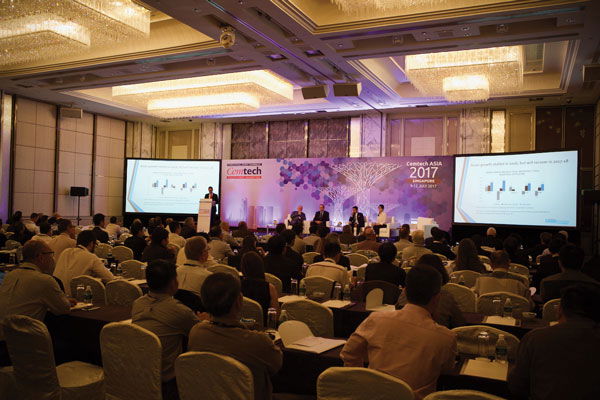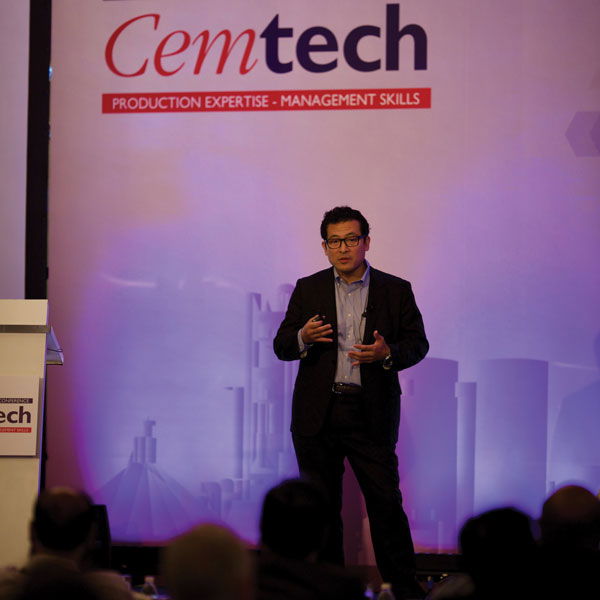Cemtech’s annual Asia conference returned to Singapore for the first time since 2008, bringing together over 200 cement producers and industry stakeholders from 40 nations. Senior industry figures shared views on dynamic Asian cement industry developments and technology, with expert presentations on grinding, alternative fuels and other manufacturing topics. Another resounding success for Cemtech!

Cemtech Asia opens with a review of trends across global and Asian cement markets
In his opening remarks conference director, Thomas Armstrong, managing editor of International Cement Review, set the scene with a review of cement market trends across the world with a specific focus on developments in Asia. Worldwide cement consumption climbed by 1.8 per cent in 2016 to 4.1bnt according to data recently published in The Global Cement Report, 12th Edition. Of this, Asian countries consumed 3.1bnt of cement in 2016 (75 per cent), while south Asia alone consumed 209Mt in 2016.
Asian growth outside of China stalled in 2016, falling by 0.2 per cent in south Asia, due to weakness in key markets such as Thailand and Malaysia. Looking ahead to 2018, however, cement demand is expected to pick up, with 2018 growth forecast at 3.5-4 per cent.
The keynote presentation was delivered by Emir Adiguzel, CEO of HC Trading (Germany), a company that traded 24Mt of cement and fuels in 2016, making it a world leader in this field. Mr Adiguzel noted that although freight rates are at historical lows, global trade has softened in recent years. In 2017 the abundant surplus generated from Asia has partially dried up due to production cuts in China resulting in a lower exportable volume. Additionally, strong domestic demand in Asia, especially in South Korea, Thailand and Vietnam, are also seeing a lower exportable surplus. Meanwhile, in the Mediterranean region, resilience in the European markets is also restricting supply, which together with the Asian situation is reflected in higher export prices.
Following on, Manas Tamotia, managing director of LEK Consulting (Singapore), presented a slightly more cautionary view from the perspective of the south Asian markets, arguing that significant oversupply is now becoming a critical issue. Demand in the region has stalled, he warned, while capacity has continued to increase. Furthermore, regional markets should be wary of the potential impact of China’s 800Mt theoretical surplus, with current export levels still below their 2006 peak of 36Mt.
This view was challenged by Grace Chen, vice director of the China Cement Association, who argued that while China may be entering a phase of lower growth, the industry would rein in any surplus through aggressive capacity reductions, and that no significant export surge would materialise. Indeed, by 2020 the industry will shut down 400Mt of clinker capacity, to address the supply-demand balance, and it targets utilisation rates of 80 per cent, up from their current level of 68.1 per cent.
Turning to southeast Asian markets, independent industry consultant Martin Wilkes explained that although cement consumption in Indonesia has been lacklustre of late, long-term fundamentals will continue to drive annual demand growth at around five per cent. Overcapacity exists but will gradually be absorbed by the market and he expects a reasonable utilisation rate of 80 per cent by 2018 (integrated capacity only).
Staying with the region, Lan Nguyen, MD of StoxPlus (Vietnam), offered an insightful overview of the Vietnam cement sector, where domestic sales expanded at a rate of 5.7 per cent in the 1Q17. Ms Nguyen also reviewed the Vietnamese concrete market, which is rapidly developing, with consumption reaching 46.8Mm3 in 2016. In spite of the healthy domestic growth Vietnam has a considerable capacity surplus. In 2016 volumes of cement and clinker exports reached 17.1Mt, and continued to expand by 10 per cent in 1Q17.
Trade and logistics
Marilyn Gardner, MGardner Consultancy (Australia), observed how the role of cement trading has become an increasingly important tool for the industry to manage surpluses and maintain stability in domestic markets. In 2016 cement and clinker exports in the Asia-Pacific region reached 66.5Mt, led by China (18Mt), Vietnam (14.7Mt), Japan (11Mt) and Thailand (11Mt). In her view, China is expected to export less in 2017 at just 11Mt compared to the year before, as a result of government initiatives to reduce domestic production. The main importers will be Bangladesh (mainly clinker), the Philippines (demand from new infrastructure) and Hong Kong (airport expansion).

The conference programme sparked plenty of interest
from the audience of over 200 cement industry specialists
Grinding technologies
Ricardo Gonzalez-Haba, GlobBulk (Spain), explored the opportunities for low-cost modular grinding plants. He argued that investors should not lose sight of the fact that civil works account for the largest proportion of any project, with mechanical and electrical equipment accounting for only 44 per cent.
Moisés Nuñez, Cemengal (Spain), a leading exponent of modular mills, followed up with an impressive review the company’s worldwide references. The latest offering is the XL Plug&Grind, two units of which have recently been installed by Cemindo at Medan, Indonesia.
One of the conference highlights was a presentation by Dr Joe Khor, CPB Engineering (Malaysia), who recounted the construction of the new 1Mta grinding station for CMS in Sarawak, Malaysia. The new plant is equipped with a 150tph ball mill supplied by Christian Pfeiffer (Germany) and Dr Khor explored the strengths and weaknesses of this grinding technology. He concluded that while the VRM may offer the lowest specific energy consumption, ball mills can offer lower total investment cost given their higher plant availability and lower maintenance costs, making them a popular option for cement producers.
The grinding theme was continued by Christian Altherr and Phillip Hempel, Gebr Pfeiffer (Germany), who discussed the company’s VRM installations, ranging from small modular units (ready2grind) to extra-large grinding stations with capacities of up to 450tph.
Boris Humpola and Mitchell D’Arcy of Wagners Cement (Australia) described the construction of the company’s Pinkenba grinding plant at the Port of Brisbane. Wagners opted to install a 100tph UBE vertical mill (UM42.6) for its energy efficiency and ability to switch between grinding slag and clinker. The steps used to optimise the mill at commissioning included adjusting the water spray volume and entry point, grinding aid supply and entry point, dam ring height optimisation, introduction of nozzle ring vanes and modification of separator blades.
Comparing the new VRM to the company’s existing ball mill, Wagners found the ball mill availability to be higher at 97 per cent, and maintenance costs to be lower at AUD2.90/t versus AUD3.50/t for the VRM. However, the specific energy cost (fuel and electricity) to produce ground blast furnace slag on the VRM was less than half compared with the ball mill.
Alternative fuels
Alternative fuels (AFs) continues to be one of the most eagerly-anticipated topics on the Cemtech technical agenda, and this meeting was no exception. Peter Hoddinott, previously CEO of Lafarge Africa and Regional Director for Lafarge Western Europe, provided the keynote speech on the socio-economic optimisation of AF. In Asia AF utilisation is currently at a far lower level than in Europe, and the presentation began with the arguments in favour of using AF, namely reducing waste, minimising CO2 and diversifying fuel portfolios.
Engaging the community, he argued, is one of the cornerstones of any alternative fuels strategy, because without local consent, there can be no licence to burn. Once a plant decides to introduce AFs, there are a range of issues to consider. AF availability depends on the level of industrialisation and changes over time as a country develops: so a cement plant cannot select just one fuel – it will need to be able to adapt over time to multiple moving markets. On the technical side, therefore, plant mastery is required to manage the different fuel streams. However, not all plants are suited to alternative fuels and there is often the case of economic viability. In the case of a sold-out plant, for example, introducing alternative fuels may be economically disadvantageous due to a higher unit fuel cost and lower available capacity resulting from AF utilisation. A rigorous feasibility study needs to be conducted before embarking on an AF programme.

Tetsuo Yokobori presents an insightful overview of the
energy strategy pursued by Sumitomo Osaka Cement’s
Ako plant in Japan
Continuing with the agenda and moving through the cement manufacturing process, Mogens Fons presented a case study where Fons Technology (Turkey) retrofitted a 12,000tpd clinker cooler at the Narli plant in Turkey in just two weeks – a record achievement.
Yang Zhi, CBMI Construction Co/Sinoma (China), presented the advantages of turnkey plant construction on an Engineering, Procurement and Construction (EPC) contract basis, which although may not be as cheap as traditional ‘multi-package’ projects, does allow the investor to transfer the management and risk of the entire project to the contractor.
Siegfried Andräß, Sick AG (Germany), explained how gas measurement technologies can be used to continuously monitor kiln combustion, allowing timely action to be taken to reduce preheater blockages, illustrated with a case study from Çimsa (Turkey). Andreas Renetzeder, Scheuch (Austria), provided an overview of SCR technologies for NOx, VOC, CO and odour reduction.
Gary Heath, Castolin Eutectic (Switzerland), presented advanced maintenance technologies and the application of low weight, high-quality wear protection with tungsten carbide using laser cladding technology. Meanwhile, Yannic Sesemann, Köppern (Germany) described the zero maintenance Hexadur wear protection system for roller presses utilising hexagonal tiles made of carbide-rich metal matrix composites.
Alan Tran, Aumund Asia (Hong Kong), took delegates through the processes required to upgrade an existing chain bucket elevator, which in certain cases can result in benefits of up to 80 per cent increased capacity and a 35 per cent reduction in direct costs.
Lars Havsteen Jensen, FLSmidth (Denmark), explored the ways in which cement companies can benefit from a business model where the plant owner hands over full operation and maintenance to a third party such as FLSmidth, freeing the owner to focus on other responsibilities of the business, such as sales and marketing. This model has had great success in Africa and in Egypt where FLSmidth claim to operate a plant with the lowest costs of goods sold at EGP329/t (US$18.50/t).
Creating and consolidating new business links
Cemtech Asia was accompanied by a large equipment exhibition, which also offered a venue for delegates to network while exploring some the newest technologies now available to cement producers worldwide.

Cemtech Asia was accompanied by a large equipment exhibition, allowing delegates to network
and learn more on the newest cement industry technologies now available
The event was concluded by a well- attended Gala Dinner, with entertainment and a 10-course Chinese banquet – ensuring Cemtech lived up to its reputation for generous hospitality and provided all participants with the chance to enjoy consolidating new friendships and business links.
Visit to the world’s largest cement import terminal

Delegates had the opportunity to
visit the world’s largest common-
user terminal in Jurong Port
This article was first published in International Cement Review in September 2017.
